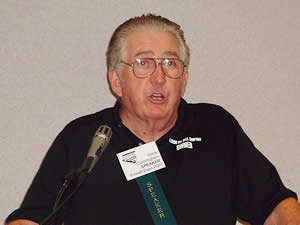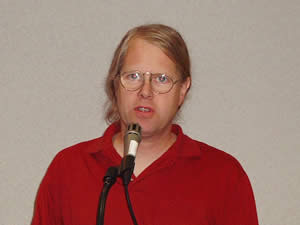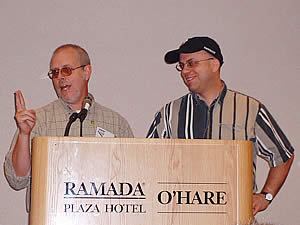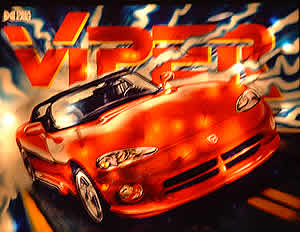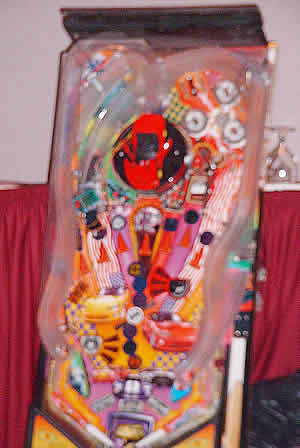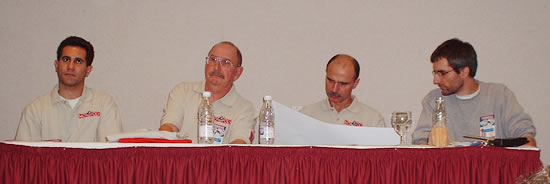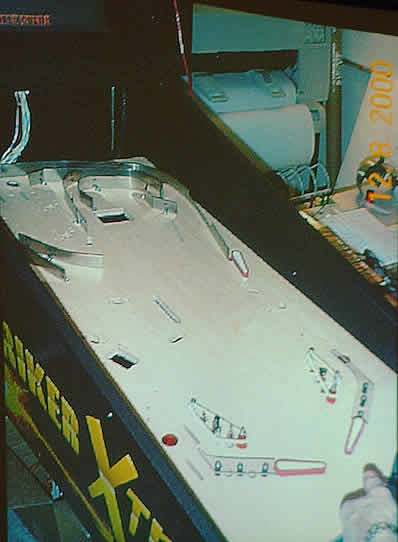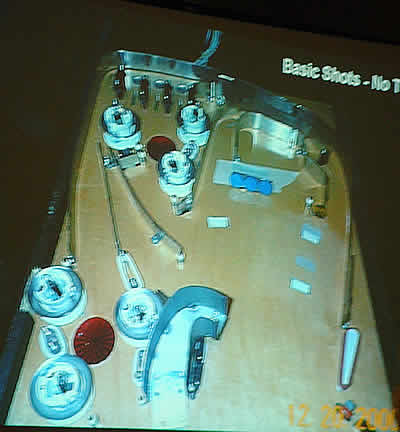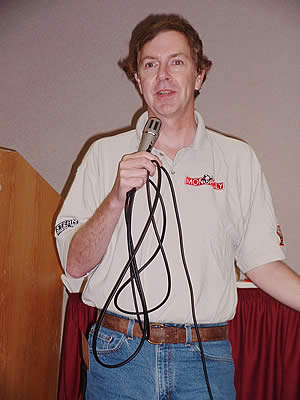
PINBALL
EXPO 2001
SEMINARS
|
The seminars are an integral and popular part of Pinball Expo and this year there was an excellent selection of speakers. In a new development for Pinball News, we will bring you some audio clips of two of the most important speakers from this year: Founder of the Illinois Pin Ball Company, Gene Cunningham and legendary pinball designer Pat Lawlor. These are available in MP3 format with a low 20Kbps rate so you can download them fairly quickly even with a 56K modem.
On Thursday, the tough task of kicking off this years seminars went to Australian speaker Michael Shalhoub. He talked about the pinball situation in Australia and described his work on a book to pay tribute to his heroes of pinball. Work on this is almost complete and publication should be early next year. As in all the seminars, there followed a lively question and answer session with the audience.
The
next speaker was Don Caldwell who described his method for cleaning
and polishing mylar covered playfields. He showed how to make a polishing
tool using a lambswool polishing bonnet, some T-shirt material, a sanding
tool and some duck tape.
After that, Richard Shapero hosted the "Learn Hot To Play Pinball" seminar where attendees were taught basic ball control skills such as you will find in our Skills section.
Friday's seminars started early at 8:30am when "Dr" Scott Sheridan talked about repairing pinball machines in his "Fixing Pins For Fun And Profit: Pinball Marketing 101". Sadly I have to confess I was attending another private seminar at this unearthly hour entitled "Sleeping Late for Rest and Relaxation" in room 1405. Sorry Scott.
By 9:15am, however, I was back and wide awake for Jeff Rietschel's talk on "The Clippard Pneumatic Pinball Machine". You will have seen pictures of this pinball game in our exhibition hall report but in his seminar Jeff talked about the challenges and reasoning behind building the game in the first place. Clippard is a company who manufactures pneumatic devices and made this game as an exhibition device to drive interest in their products. Show co-organiser Rob Berk saw the game at an industry show and persuaded Jeff to bring it to Expo and talk about it.
Gene has also bought the pinball playfield company TAG and he is poised to start making new pinball playfields pending copyright issues. He said that the first games to be made will probably be Kiss and The Addams Family as demand for these is greatest at the moment. Probable price for these is around $300. It looks like parts from IPB are now being shipped and some new parts are being manufactured where possible using the original tooling. He should by now have 200 Monster Bash and Cactus Canyon cabinet side panels in stock - they were being made by the original company hopefully with better glue this time. One of the most interesting discussion points looked the the concepts on NOS and reproduction parts. NOS (New Old Stock) are parts which were made originally by the company and are the same as those actually used on the game in question. Reproduction parts are obviously made by another party and designed to look as similar to the original parts as possible. Repro parts sometime try to improve on the original design. With IPB making
new parts, the discussion centred on whether these are NOS parts or
repros. If the original tooling is used and perhaps the same company
makes them, are they in fact any different from the originals? It's
not an easy question to answer but the consensus was that it didn't
really matter when the parts were made as long as they were visually
identical to the original. Following Gene was game collector and restorer Tim Arnold who spoke about his collection in Las Vegas and his plans to set up a Pinball Hall of Fame.
Tim was selling
Simpson's T-shirts at the Pin Game Journal stand to help raise funds
for the building.
Their seminar was liberally sprinkled with video clips showing their disassembly of a pinball 2000 system and how to test each component. Amongst other things they showed how to remove scratches and remove wear around playfield inserts. One of the most spectacular demonstrations shows how to remove scratches and ball tracks from clear plastics and ramps using a blowtorch. This was followed by a video presentation of clips and out-takes from their This Old Pinball video series. Included in this was what happened when you took a pinball into the woods and threw a large lit firework inside, and how to set fire to a Twilight Zone.
After lunch Don Beach described the various sound systems used on pinball games of the '80s and '90s, their amplifier set-ups and how his replacement speaker systems can enhance the sound of these games. Don sells a range of speaker replacements for each sound system from all the manufacturers of that time. You can replace either the cabinet speaker or the backbox speakers or both together. There was a stand in the exhibition hall where you could hear the enhancements.
Mark Bakula then talked about the evolution of the Sega Viper Night Drivin' pinball game. The original idea of a Viper game went back to the days of Data East and the game was made in a smaller size than a regular pinball at the request of distributors. Sadly they didn't like the end result and it was never developed further.
The next speaker was Joe Blackwell, Stern Pinball Inc's Director of Parts Sales and Technical Support. He was demonstrating basic faultfinding techniques on Stern's pinball games. He showed how to test non-functioning coils both at the hardware level and using the inbuilt diagnostic software. Audience members were invited to try out these techniques on an Austin Powers game. He also handed out free jumper leads and copies of the manual for Sharkey's Shootout. For anyone who has never seen a Stern manual before it is a real eye-opener. There is a real mass of information between the covers - not only the expected lamp and switch matrices and schematics but top, front and side views of assemblies, opto troubleshooting guides, the game's instruction card and a full firmware guide for every DE/Sega/Stern game to date.
The final seminar of Pinball Expo 2001 was the ever popular Pat Lawlor Show. There was a short delay while all the goodies and people were assembled. Steve Kordek stepped up to talk a little about his 60+ years in the pinball industry and answer a few questions from the audience. Before long Pat was ready for the show where he was joined by fellow Pat Lawlor Design team members Louis Koziarz, John Krutsch, John Youssi and Greg Dunlap (below).
First, Pat talked through a slide show about the development of Monopoly and set the background for the game.
Some of the key points raised in the discussion were:
And that concluded this years seminars from Pinball Expo. It's true to say that the seminars more than anything else set Expo apart from other pinball shows around the world. The chance to listen to and question some of the foremost authorities on pinball past and present is worth the entry price alone. It's a brave man or woman who thinks they won't learn quite a lot from attending and listening to them. Hopefully the audio clips included here will give those of you not able to attend a feel for what the seminars are like. And with that we nearly reach then end of this Pinball Expo report. I was concerned while travelling to Chicago that the show couldn't live up to the great past performances of previous years and as I said earlier the number of exhibition games has fallen. Also, I got the feeling that perhaps the organisers had lost much of their motivation for running the event. Has the criticism taken its toll? Rob Berk's welcome speech at the Bumper Blast luncheon might just have stretched beyond one sentence depending on how you interpret the punctuation and that was just followed by showing the first 95% of the film Tommy. One other negative is the way registration was handled. If you registered on the day you received a plain badge and just told to write your name on it. I used my 1999 badge and never had a problem. No checks are made to see if those on the factory had bought tickets (the same has happened every year I can recall), and no checks were made on entry to the seminars. A less scrupulous person could probably have made it all the way through the show without buying a ticket at all. But ultimately these are minor quibbles. I had a great time not only for the games I played but mainly for the people I met. There were many first-time visitors this year and those I spoke with thoroughly enjoyed the show too. I had heard rumours that this might be the last Expo as Rob and Mike wanted a rest. All the events planned for next year hopefully mean that this won't be the case, though I'd support a change of venue to a cheaper hotel and one where the fire alarm doesn't go off at 6:30am on the last night. :-) Next year? Well, if I guess right, the next PLD game should be out just around Expo time next year and you wouldn't want to miss another show like this one, would you? That's the end of our Expo review. Don't forget to listen to the audio clips or you can jump back to the previous sections. Click here to see part one. Click here to see part two. Click
here to listen to the audio clips.
© Pinball News 2002 |
